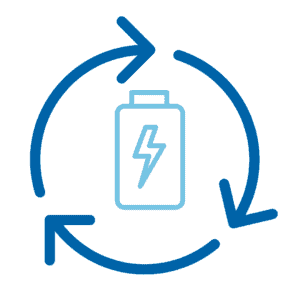
Battery recycling is crucial in addressing battery waste management. With the number of electronic devices being discarded each year, and the number of EV batteries reaching end-of-life increasing in the coming years, proper recycling will ensure that cells are taken care of properly, protecting people and the environment from the adverse effects of ill-disposed batteries.
Even though a battery may no longer be usable, this does not mean that the materials within the cell are useless. On average, 80% of lead in new lead-acid batteries is recycled, showing that there is great potential for reusing materials.
How exactly are materials extracted from a spent cell?
Lead-acid batteries
The process of recycling lead-acid batteries is already quite mature, as these batteries have been in use in automobiles and other applications since the 1900s. The composition of these batteries is also simple and straightforward, making the process of recycling quite easy.
A lead-acid battery consists of lead, a plastic coating and sulphuric acid. The batteries are first broken apart and the sulphuric acid is neutralized and turned into sodium sulphate. The lead and plastic are separated by placing the battery pieces into a vat. The plastic floats to the top and the lead sinks to the bottom.
All three components are recycled: sodium sulphate is used in fertilizer and detergent, and the lead and plastic are either used in new batteries or other industrial products.
Lithium-ion batteries
There are two processes through which materials within lithium-ion batteries can be extracted. The first process is called pyrometallurgical recovery. This process makes use of high temperatures to smelt the battery and recover cobalt, nickel, and copper. However because of the extremely high temperatures, lithium, aluminum, and other organic compounds are burned away, leading to a relatively low recovery rate.
Hydrometallurgical post-processing is the alternate extraction process. It makes use of aqueous solutions to leach metals from the cathode. Lithium-ion cells are soaked in strong acids that dissolve the metals into a solution. This process is less energy-intensive and cheaper and can also recover lithium and copper on top of the other metals, allowing for a higher rate of recovery. However, chemical leaching also requires caustic reagents such as hydrochloric, nitric, sulfuric acids, and hydrogen peroxide to extract the materials.
Some recyclers make use of a combination of the two in order to extract materials. One recycler, Redwood, first heats the batteries to separate the metals of the cell. Then individual compounds are recovered through a hydrometallurgical process. The company claims that this method allows for a 95-98% recovery rate for nickel, cobalt, copper, aluminum, and graphite, as well as over 80% of lithium.
Many scientists are also working on safer and more efficient ways to recover battery materials for recycling. One company uses sulfur dioxide rather than hydrochloric acid or hydrogen peroxide to leach cathode materials. In theory, all materials within a battery can be extracted and reused in the battery manufacturing process.
Strong materials research will play a part in creating more sustainable and recyclable batteries in the future. Discovering and choosing materials and battery designs that are more easily processed and recycled will play a huge part in encouraging better recycling.
Learn how Arbin supports this research.

